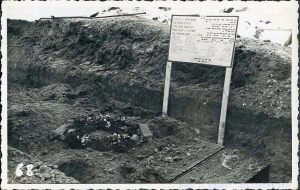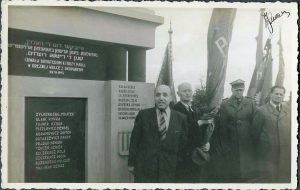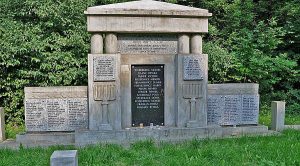The Jewish Fighting Organisation (ŻOB) Monument
by WIESŁAW PASZKOWSKI, Częstochowa Municipal Museum, History Documentation Centre
Edited: ALON GOLDMAN, Chairman of the Association of Częstochowa Jews in Israel English translation: ANDREW RAJCHER
This monument is also a war grave. It is located in Complex I of the cemetery, on the right-hand side of the main pathway, approximately two-thirds along its length. It is in the form of an aedicula (a composition consisting of two pillars, columns or pilasters which support the entablature with a pediment or outpost), a style often found in this cemetery.
It consists, however, of heavy, concrete blocks. Its entirety is set on a low pedestal. The central section consists of a massive plaque, with protrusions which make the centre recessed. The panel is made into a central inscription plate, with highlighted colour and made of black granite. On both sides, there are bas-reliefs of stylised menorahs containing burning candles. Two pairs of low columns are placed above the protrusions, between them is a horizontal plaque containing the main monument inscription. The peak is in the form of a flattened prism set on a massive horizontal beam. A Star of David sits above it all. Two lower panels, containing inscriptions, have been added to both sides of the aediculus. In front of the monument is an open frame outlining the area of the grave. The frame contains posts, originally finished with stylised burning torches. Metal chains have been hung between the posts.
The current form is the result of a renovation carried out by the City Council in 2012, during which the central plaque was lost. Monument elements were reconstructed and grey granite inscription tablets were created using the pattern of the original and containing inscriptions which had faded from that original.
The main inscription on the monument, in Yiddish and in Polish, expresses the intentions of the authors:
Glory to those heroes who died
in the armed struggle with the occupiers
04/01/1943
Only surnames with first names follow:
| Zylberberg Mojtek | Glanc Rywka | Fajner Icchok | Fiszlewicz Mendel | Fiszlewicz Mendel |
| Abramowicz Sumek | Potaszewicz Harry | Pejsak Heniek | Tencer Heniek | Szczekacz Pola |
| Szczekacz Dosia | Rozenberg Mojsze | Frajman Hersz | Frajman Rywka | Blechsztajn Ojzer |
| Bram Bela | Blank Lolek | Berkensztadt Mojsze | Berkensztadt Rajzełe | Eksztejn |
| Fajgenblat Mojsze | Gliksztajn Jehuda | Gliksztajn Lutek | Goldberg | Najman Hipek |
| Hirsz Pola | Haftka | Jakubowicz Szymsia | Kopiński Władek | Kantor Josek |
| Kapłan Abram | Mass Jadzia | Rypsztajn Kuba | Rozencwajg Marysia | Rząsiński Izydor |
| Rodał Mojsze | Radoszycki | Samsonowicz Pinek | Szuldman Wigdor | Szymanowicz Izrael |
| Szydłowski Lejzor | Sielcer Dawid | Sztull | Szajn Joachim | Szajn Perła |
| Tuchmajer Mojsze | Trembacki | dr Wolberg Adam | Windman Icchak | Wojdzisławska Lunia |
| Wajskopf Michał | Wajntraub Mietek | Wiernik | Wigodzki | Żarnowiecki Zukon |
| Zylberszac Mojsze | Zborowska Bela | Zajde Abram | Lubling Mojsze | Rozyne Jakub |
| Rozyne Estera | Asz Mendel | Birencwajg Machel | Birencwajg Adasa | Blumenkranc Fiszel |
| Rozensztejn Natan | Lewensztajn Mojsze | Kałka Berek | Kałka Józef | Lichter Kopel |
| Brzuska Zelig | Brzuska Lipman | Brzuska Mordchaj | Kusznir Chaim | Wilinger Mendel |
| Tenebaum Lejb | Brener Chana | Brener Chaim | Brener Machcia | Brener Nelli |
| Berliner Basia | Berliner Icchak Hersz | Berliner Natan | Doński Lejb | Dońska Liba |
| Dońska Dwojra | Dońska Saba | Fiszel Abram kantor | Frank Lejbuś | Frank Hela |
| Frank Oleś | Gewercman Dow | Goldminc Abram Icek | Goldminc Cypra | Goldminc Natan |
| Goldminc Genia | Goldminc Lolek | Horończyk Idesa | Horończyk Henoch | Krauze Grojnen |
| Krauze Telca | Krauze Wolf Aron | Krauze Chana | Krauze Dana | Krauze Jakub |
| Wajchman Kuba | Krakauer Szmul | Krakauer Iśka | Krakauer Różka | Krakauer Gitla |
| Krakauer Zyskind | Krakauer Frandla | Krakauer Wolf Aron | Krakauer Abram Józef | Krakauer Josek |
| Krakauer Sala | Koniecpolski Eli | Koniecpolska Gitla | Niemirowski Szmul | Wajchman Bala |
| Wachtel Henryk |
The key to reading the monument is a description of the historical event which it commemorates.
On 4th January 1943, early in the morning (around 5:00 am), Hauptmann Paul Degenhardt’s deputy, Lieutenant Rohn, arrived at the Rynek Warszawski (today known as “Plac Bochaterów Getta”). At his orders, all the groups of people emerging from the “Small Ghetto” were tightly guarded in order to prevent those, who were unemployed, avoiding being sent to the labour camp and then hiding from the German police. Later, all was calm, however the residents noticed that the whole area was surrounded by police and that they were being watched attentively.
At 10:00 am, Rohn told all the people living in the “Small Ghetto” to enter the Rynek Warszawski, these included all those working in the Judenrat and its office, kitchen and workshops. This operation was clearly aimed at those employed within the Judenrat office apparatus, as well as those who had evaded work (for ideological reasons, some of the youth in the Jewish Fighting Organisation (ŻOB) did not want to work for the Germans). During the course of the selection conducted by Lieutenants Rohn and Sapparta, groups of several hundred physically weak and elderly people were placed under arrest in the German guard-post. Also taken into custody was a whole group of young people who had originally been barracked in a house at ulica Nadrzeczna 66, forming a branch of ŻOB (known as the “66” from the address). This was the “penalty” for coming late to the selection.
Later, Jewish policemen were ordered to search for hidden children. Because, at first, they did not find anyone, Rohn gathered them together and declared that each of them had to find at least two children and was responsible for carrying out the order at the risk of their own head. Now, the police began to act with total ruthlessness, breaking into apartments, pulling children out from under beds, from basements and from attics.
The children were loaded onto carts which had been used for waste disposal and sent to the Polish police station at ul. Piłsudskiego 21. Then it was the turn of those under arrest. The Germans did not expect any difficulties. However, the “66” group, led by Mendel Fiszlewicz (an escapee from the camp in Treblinka), decided that they would not allow themselves to be passively placed onto a transport. The sound of shots was to be the signal for escape. Fiszlewicz and his friend Izaak Feiner put up armed resistance. Fiszlewicz shot at Rohn, wounding him. But the pistol jammed and so he could not fire again. Feiner only had a knife which he used to slightly wound Sapparta. Stunned for a moment, the German police fired at the rebels, killing Fiszlewicz and fatally wounding Feiner. Only two girls managed to take advantage of the confusion. They were from another youth group – “Kibbutz”. Unnoticed, they joined those who had not been selected.
All the Jews in the Square were forced to raise their hands and to step back behind barbed wire. Out of the group standing nearest to the incident, the police selected every tenth person – twenty six individuals. Each of them was sentenced to death. Among them was the Commander of the Jewish Police and Judenrat member, Maurycy Galster. Until then, people prominent in the ghetto had avoided any repressions. Greatly concerned, the Chairman of the Judenrat, Leon Kopiński, succeeded in having Galster freed. The remainder were escorted past the fence and were shot against the wall of the nearest building.
The several hundred Jews in the Warszawski Rynek were surrounded by German police and led to the police station on Piłsudskiego. The Germans continued to search the camp grounds. One of them noticed two women, a mother and daughter, who were coming out of their apartment and were trying to cross over to the “Aryan side”. They were carrying money and valuables. He shot at them, but missed. However, one of them stopped. He ordered them to hand over all that they had and then told them to go. As they left, he shot, killing both of them on the spot.
It was now that groups were returning to the camp from their workplaces. Many could not find their family members – those who had been shot or who had been led away to the police station. They saw the twenty seven bodies lying in the street. Among them, they recognised friends and family members. It was already after dark when the bodies of the twenty seven men were buried in two mass graves, next to the bodies of the mother and daughter. For a long time, people stood by the graves. They only dispersed when ordered to do so.
On the following day, Judenrat Chairman Leon Kopiński tried to have freed those who had been imprisoned on ul. Piłsudskiego. He claimed that some of them were vital to the work which the Judenrat had been ordered to carry out. Lieutenant Rohn declared that they would be released if the Jewish Police would provide the same number of children and adults of lesser “value”. The Jewish Police again began the hunt for hidden children. The exchange took place on the square of the police station. Later, two hundred children and several hundred adults were transported to Radomsko. From there, together with other Jews from that town, they were transported to the extermination camp at Treblinka.
In January 1946, the Częstochowa Jewish Committee (chaired, at the time, by Liber Brener) organised the exhumation of the bodies of those executed on 4th January 1943. The local Jewish community took part in the event. The exhumed bodies were moved to the Jewish Cemetery and buried in a common grave. On one of the photographs, one can see a temporary wooden plaque, bearing inscriptions in Polish and Yiddish, which was placed onto the grave:

In honour of those, of blessed memory, victims of Nazi bestiality who died in the Częstochowa ghetto on 4th January 1943.
| Fajner Izak | Amsterdam | Fiszlewicz | Iszajewicz Dow | Haftka Jojne |
| Hammer | Wiernik | Wajdenbaum Moszek | Wygodzki Szmul | Zilberszac Abram |
| Trębacki Lejzor (?) | Eksztajn | Frajman Hersz | Potaszewicz | Rodał Moszek |
| Rozensztajn Natan | Rychter Jakób | Szelcer Dawid | Sztal Boruch | Goldberg Gedalia |
Twenty men are named on it.
It was only three years later, when the temporary plaque no longer existed or was already illegible. Then a monument with a completely different inscription was placed there.
The difference in the sound of the Yiddish and Polish inscriptions is distinctive. The first is precisely: Eternal glory to the heroes who fell during the first armed attack against the German executioners. It can be seen that the monument has been dedicated not to the victims, but to the heroes. The group of those honoured had been broadened. To the names of those killed in the incident on 4th January 1943, which had been reviewed (which is evidenced by significant differences such as spelling mistakes and the omission of names of individuals), have been added the names of many others.

Thirteen names had been engraved on the central plaque, which is distinguished by its colour (probably made of black granite): ŻOB Commander “Mojtka” Zylberberg, Rywka Glanc, Feiner and Fiszlewicz, four partisans known from other armed operations, the young Szczekacz sisters who had formed the “66” group, not mentioned in the accounts and memoirs of Mojsze Rozenberg and the Frajman couple. Hersz Frajman was one of the execution victims and, from 1905, was also a known Bund activist. His wife, Rywka, was also a respected Bund activist and instructor. In 1906, she had been seriously injured. On 4th January 1943, on hearing the news of her husband’s death, she had a mental breakdown. She took up her grandchild and volunteered to go on the transport, knowing that this would mean death. That order of events determined a certain hierarchy and became almost symbolic. At the same time, such a set of names contradicted the inscription – especially in the Polish wording.
In other places on the monument, the names of the “66” group are mentioned abundantly. When the ghetto was liquidated, many people were included, but the core was formed by:
Izio Feiner, Mietek Ferleger, Mendel Fiszlewicz, Lolek Frankenberg, Harry Gerszonowicz, Rysia Gutgeld, Lusia Gutgold, Sara Gutgold, Hipek Heiman, Pola Hirsz, Jadzia Mass, Awiw Rozyner, Marysia Rozencwajg, Saba Rypsztajn, Kuba Rypsztajn, Maniek Rozencwajg, Dosia Szczekacz, Pola Szczekacz, Mietek Wajntraub, Lunia Wojdzisławska, Icek Windman, Zborowska, Samsonowicz, Wojdzisławski, Frankenberg and Benclowicz.
Who were the other heroes of the monument? Among them was Machel Michał Birencwajg, who is named along with his wife Hanka Hadasa. During his school days, Michał was active in the Zionist movement, but he later moved to a communist organisation. During the occupation, he was employed as an upholsterer and soon became the Jewish director of the furniture plant, namely, the Moebellager. During the mass deportations of September and October 1942, he saved hundreds of lives, helping escapees from blockaded streets and hiding people in the Moebellager. He would later smuggle them into the “Small Ghetto”. He formed the underground movement quite early, during the period of selections and blockades, during the most horrible terror. He enjoyed a position of the greatest authority amongst his companions. On 8th June 1943, Michał avoided being caught by the police. However, on that day, his mother died. His wife was detained and, two days later, was shot. Michał had “Aryan papers”, but he did not try to save himself by fleeing from Częstochowa. Robbed by the Poles who were hiding him, he was handed over to the Germans, who killed him at the Jewish Cemetery on 28th July 1943, along with a group of sixty Jews.
Dr Adam Wolberg is also named on the monument. He was a dermatologist and a professional officer, a captain in the Częstochowa Regiment. He fought in 1939 and became a prisoner-of-war. After returning from imprisonment, he worked as a doctor for the Society for the Protection of the Jewish Population (TOZ). He was one of the organisers and directors of the activities of the underground. In particular, he fought fiercely with the Judenrat. He favoured armed resistance against the Germans and, at the end of 1942, in discussions with various Jewish parties and organisations, he represented the Bund. He was nominated by the Bund as the military commander. In unknown circumstances, the leadership of ŻOB was taken over by a young group of Zionist activists. However, they lacked preparation for any armed underground activity. Adam Wolberg was exposed. He was caught in a German round-up and, on 19th March 1943, he was shot. He deserved a more prominent place on the monument. However, in 1949, it was not possible to include him due to his Polish Army.
Mojsze Lubling was one of the most active members of the Arbeter Rat collective, which actively defended the interests of Jewish forced labourers in 1941 and 1942. He was transported to Treblinka and worked there as a commando member. He was one of the organisers and leaders of the uprising, in which he perished, in August 1943. He was not present in Częstochowa in January 1943, but he was already considered among its heroes. That paved the way for him to be included on the monument.
A surprise is the inclusion, on the monument, of Cantor Abram Fiszel of the New Synagogue. He was born in 1885 in Sosnowiec. He was a singing teacher and cantor and, according to the reports of various people, he perished on 22nd September 1942 on the streets of Częstochowa, as one of the first victims of deportation. His body was probably buried in the grave on ul. Kawia. His wife and three daughters perished in Treblinka. Only one daughter survived – Laja Danziger, who was in Łódż under “Aryan papers”.
Noteworthy is the omission of the two women killed on the same day (only one author mentions them – Szlomo Waga), even though the exhumation of the graves should have revealed them lying side by side.
Families named on the monument are Brener, Doński, Frank, Goldminc, Krauz and Krakauer. The first of these named families is a typical example. Chana, Chaim and Machcze Brener are the mother, brother and sister-in-law of the chairman of the Częstochowa Jewish Committee. They came from the small town of Turzysk in Wołyn. The son, Liber, took in his widowed mother probably before the War. In 1942, Chana was deported to Treblinka and was murdered there. The brother and his wife continued to live in Turzysk and perished there in 1942. Named along with them is Nelli, probably their daughter
As can be seen, this monument became a place of remembrance of various people and events. It was formally dedicated to the participants and heroes of the first attempt at armed resistance on 4th January 1943 – two weeks before that which occurred in the Warsaw Ghetto, where the Germans were attacked on 18th January 1943. Częstochowa residents claimed this as an historial “first”. Because the participants were members of the ŻOB fighting group, the entire group was commemorated on this monument, including the names of its leaders and many of its members. The founders and managers of the Arbeter Rat are also named, as are later prisoners in Treblinka and participants in the uprising there.
It is not limited to naming members of Jewish families just from Częstochowa. Others have been included who perished at various times and in various places.


